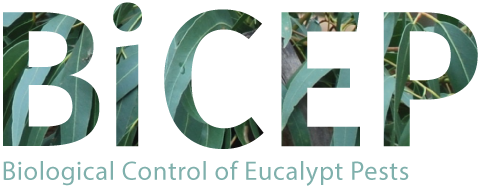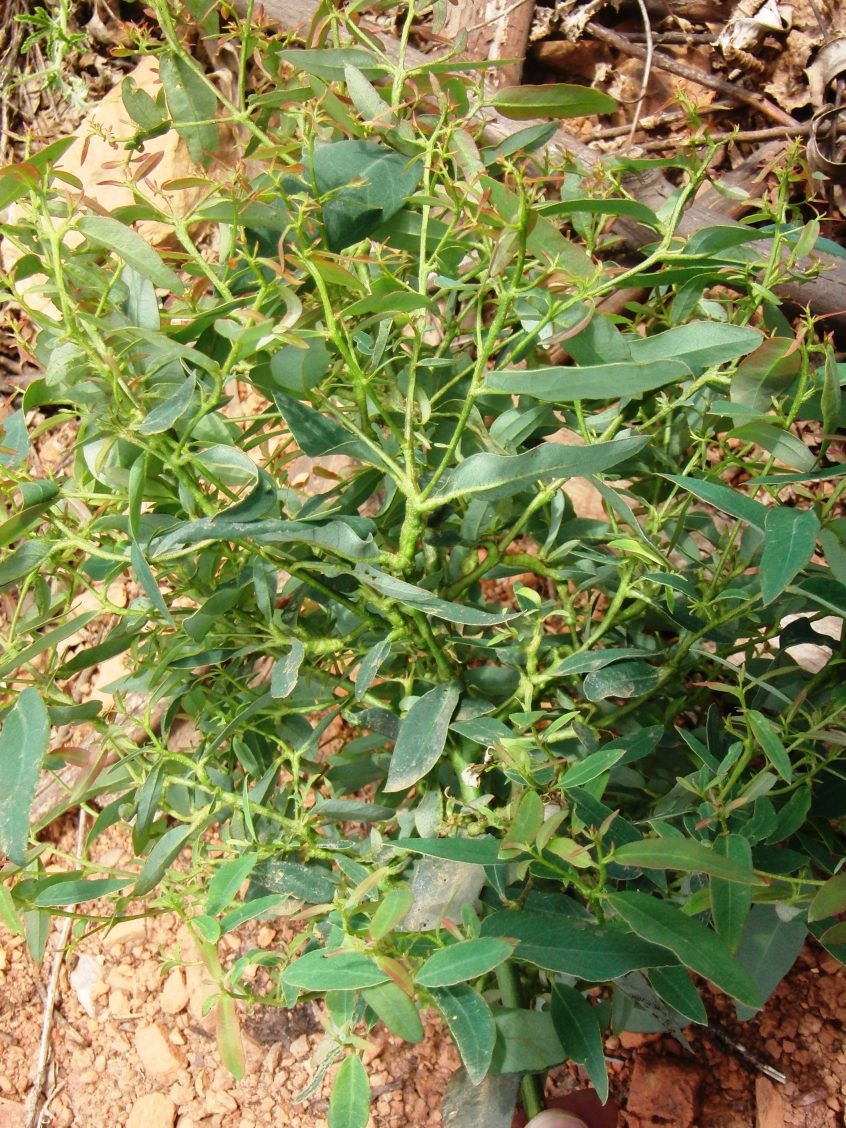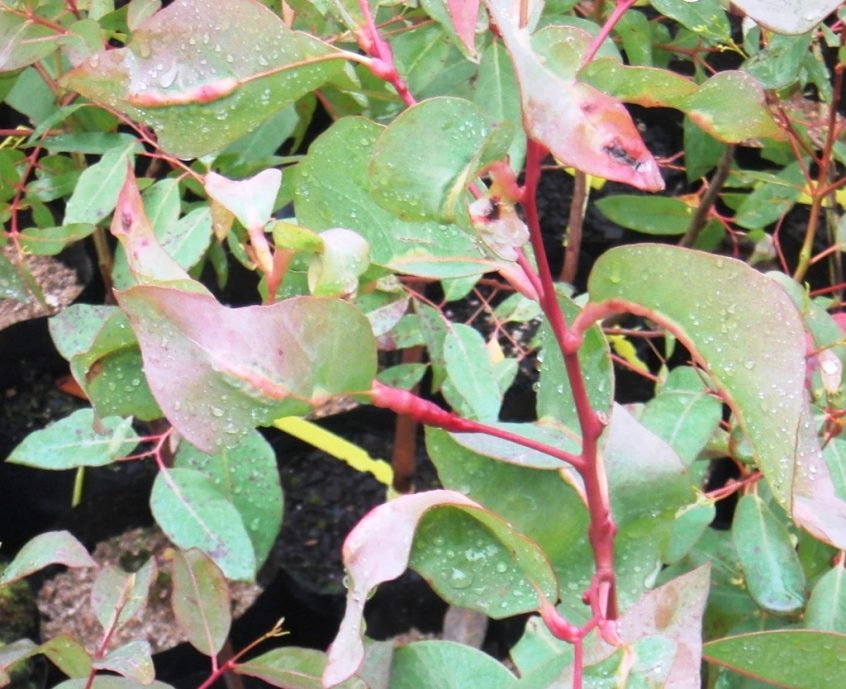Leptocybe invasa
Leptocybe invasa
The blue gum chalcid (Leptocybe invasa; Hymenoptera: Eulophidae: Tetrastichinae) is one of the most severe invasive eucalypt pests affecting plantation forestry worldwide. Since its initial establishment overseas in the Middle East and the Mediterranean region in 2000, L. invasahas spread within a period of 10 years to all continents where eucalypts are grown.
The female lays her eggs in young shoot tips and midribs of juvenile leaves, which induces extra growths (galls) to develop around the eggs. When the eggs hatch, the maggot-like larvae feed and develop inside the gall. Fully developed larvae pupate inside the galls and emergent adults chew their way out of the gall. The adult blue gum chalcid is mainly black and about 1.4 mm long.
The blue gum chalcid (Leptocybe invasa; Hymenoptera: Eulophidae: Tetrastichinae) is one of the most severe invasive eucalypt pests affecting plantation forestry worldwide. Since its initial establishment overseas in the Middle East and the Mediterranean region in 2000, L. invasahas spread within a period of 10 years to all continents where eucalypts are grown.
The female lays her eggs in young shoot tips and midribs of juvenile leaves, which induces extra growths (galls) to develop around the eggs. When the eggs hatch, the maggot-like larvae feed and develop inside the gall. Fully developed larvae pupate inside the galls and emergent adults chew their way out of the gall. The adult blue gum chalcid is mainly black and about 1.4 mm long.
Distribution
Native – Australia; Invasive – Iran, Israel, Turkey, Mediterranean Basin, sub-Sahara and South Africa, India, Thailand, Laos, Vietnam, Argentina, Brazil, Chile, Uruguay and Florida (United States).
Distribution
Native – Australia; Invasive – Iran, Israel, Turkey, Mediterranean Basin, sub-Sahara and South Africa, India, Thailand, Laos, Vietnam, Argentina, Brazil, Chile, Uruguay and Florida (United States).
Hosts
Many Eucalyptus spp. including Eucalyptus tereticornis, E. camaldulensis, E. urophylla, E. exerta, E. botryoides, E. bridgesiana, E. globulus, E. gunnii, E. grandis, E. robusta, E. saligna, E. viminalis and Eucalyptus hybrids
Hosts
Many Eucalyptus spp. including Eucalyptus tereticornis, E. camaldulensis, E. urophylla, E. exerta, E. botryoides, E. bridgesiana, E. globulus, E. gunnii, E. grandis, E. robusta, E. saligna, E. viminalis and Eucalyptus hybrids
Damage
- Galls form mainly on young shoots and along both sides of the midrib on juvenile leaves, but in heavy infestations egg-laying may cause galls to develop in the leaf tissue and twigs. Gall size varies.
- Gall formation on leaves of eucalypts causes deformation in terminal shoots and leaves, and causes more rapid leaf abscission and shoots to dry out.
- Sap oozes from the oviposition holes and galls begin to develop. The infested tissue swells, becoming pinkish and developing into a series of lumps
Damage
- Galls form mainly on young shoots and along both sides of the midrib on juvenile leaves, but in heavy infestations egg-laying may cause galls to develop in the leaf tissue and twigs. Gall size varies.
- Gall formation on leaves of eucalypts causes deformation in terminal shoots and leaves, and causes more rapid leaf abscission and shoots to dry out.
- Sap oozes from the oviposition holes and galls begin to develop. The infested tissue swells, becoming pinkish and developing into a series of lumps
Monitoring
Galling is easily seen. If damage is severe within a plantation, monitoring plots should be established to determine the amount of crown damage and which section of the crown has been affected (entire, lower, middle or upper sections of the crown). Repeat regularly to determine the rate of spread of Leptocybe invasa.
Monitoring
Galling is easily seen. If damage is severe within a plantation, monitoring plots should be established to determine the amount of crown damage and which section of the crown has been affected (entire, lower, middle or upper sections of the crown). Repeat regularly to determine the rate of spread of Leptocybe invasa.
Impact
- Severe galling causes the loss of apical dominance, growth retardation and stunting in trees.
- Most plantations are even-age monocultures, and sometimes genetically identical. All the trees may be susceptible at the same time (e.g. when they produce growth flushes, resulting in a massive pest or disease outbreak).
- Outbreaks may occur in nursery seedlings and plantations, particularly up to two years of age.
Impact
- Severe galling causes the loss of apical dominance, growth retardation and stunting in trees.
- Most plantations are even-age monocultures, and sometimes genetically identical. All the trees may be susceptible at the same time (e.g. when they produce growth flushes, resulting in a massive pest or disease outbreak).
- Outbreaks may occur in nursery seedlings and plantations, particularly up to two years of age.
Daane, KM, Sime, KR & Paine, TD (2012): Climate and the effectiveness of Psyllaephagus bliteus as a parasitoid of the red gum lerp psyllid. Biocontrol Science and Technology 22, 1305-1320
Dias, TKR, Wilcken, CF, Soliman, EP, Gil-Santana, HR & Zache, B. 2012 Occurrence of Atopozelus opsimus preying on nymphs and adults of Glycaspis brimblecombei. Phytoparasitica 40, 137-141.
Jones, ME & Paine, TD. 2012 Associations between invasive eucalyptus psyllids and arthropod litter communities under tree canopies in southern California. Entomologia Experimentalis Et Applicata 143, 280-291.
Oliveira, KN, de Jesus, FM, Silva, JO, do Espirito-Santo, MM & Faria, ML. 2012 An experimental test of rainfall as a control agent of Glycaspis brimblecombei Moore (Hemiptera, Psyllidae) on seedlings of Eucalyptus camaldulensis Dehn (Myrtaceae). Revista Brasileira De Entomologia 56, 101-105.
Percy, DM, Rung, A & Hoddle, MS. 2012 An annotated checklist of the psyllids of California (Hemiptera: Psylloidea). Zootaxa, 1-27.
Huerta, A, Jaramillo, J & Araya, JE. 2011 Establishment of the red gum psyllid parasitoid Psyllaephagus bliteus on Eucalyptus in Santiago, Chile. Forest Systems 20, 339-347.
Huerta, A, Faundez, M & Araya, JE. 2010 Susceptibility of Eucalyptus spp. to an induced infestation of red gum lerp psyllid Glycaspis brimblecombei Moore (Hemiptera: Psyllidae) in Santiago, Chile. Ciencia E Investigacion Agraria 37, 27-33.
Laudonia, S & Garonna, AP. 2010 The red gum lerp psyllid, Glycaspis brimblecombei, a new exotic pest of Eucalyptus camaldulensis in Italy. Bulletin of Insectology 63, 233-236.
Paine, TD & Hanlon, CC. 2010 Integration of tactics for management of Eucalyptus herbivores: influence of moisture and nitrogen fertilization on red gum lerp psyllid colonization. Entomologia Experimentalis Et Applicata 137, 290-295.
Silva, JO, Oliveira, KN, Santos, KJ, Espirito-Santo, MM, Neves, FS & Faria, ML. 2010 Effects of Landscape Structure and Eucalyptus Genotype on the Abundance and Biological Control of Glycaspis brimblecombei Moore (Hemiptera: Psyllidae). Neotropical Entomology 39, 91-96.
Firmino-Winckler, DC, Wilcken, CF, de Oliveira, NC & de Matos, CAO. 2009 Red gum lerp psyllid Glycaspis brimblecombei Moore (Hemiptera, Psyllidae) biology in Eucalyptus spp. Revista Brasileira De Entomologia 53, 144-146.
Valente, C & Hodkinson, I. 2009 First record of the Red Gum Lerp Psyllid, Glycaspis brimblecombei Moore (Hem.: Psyllidae), in Europe. Journal of Applied Entomology 133, 315-317.
Ferreira, PJ, Wilcken, CF, de Oliveira, NC, Dal Pogetto, M & Lima, ACV. 2008 Population dynamics of red gum lerp psyllid, Glycaspis brimblecombei (Moore, 1964) (Hemiptera: Psyllidae) and its parasitoid, Psyllaephagus bliteus (Hymenoptera: Encyrtidae), in Eucalyptus camaldulensis plantation. Ciencia Rural 38, 2109-2114.
Hansen, AK, Jeong, G, Paine, TD & Stouthamer, R. 2007 Frequency of secondary symbiont infection in an invasive psyllid relates to parasitism pressure on a geographic scale in California. Applied and Environmental Microbiology 73, 7531-7535.
Santana, DLD & Burckhardt, D. 2007 Introduced Eucalyptus psyllids in Brazil. Journal of Forest Research 12, 337-344.
Sullivan, DJ, Daane, KM, Sime, KR & Andrews, JW. 2006 Protective mechanisms for pupae of Psyllaephagus bliteus Riek (Hymenoptera : Encyrtidae), a parasitoid of the red-gum lerp psyllid, Glycaspis brimblecombei Moore (Hemiptera : Psylloidea). Australian Journal of Entomology 45, 101-105.
Daane, KM, Sime, KR, Dahlsten, DL, Andrews, JW & Zuparko, RL. 2005 The biology of Psyllaephagus bliteus Riek (Hymenoptera : Encyrtidae), a parasitoid of the red gum lerp psyllid (Hemiptera : Psylloidea). Biological Control 32, 228-235.
Stone, C, Chisholm, L & McDonald, S. 2005 Effects of leaf age and psyllid damage on the spectral reflectance properties of Eucalyptus saligna foliage. Australian Journal of Botany 53, 45-54.
Erbilgin, N, Dahlsten, DL & Chen, PY. 2004 Intraguild interactions between generalist predators and an introduced parasitold of Glycaspis brimblecombei (Homoptera : Psylloidea). Biological Control 31, 329-337.
Yen, AL. 2002 Short-range endemism and Australian Psylloidea (Insecta : Hemiptera) in the genera Glycaspis and Acizzia (Psyllidae). Invertebrate Systematics 16, 631-636.
Brennan, EB, Hrusa, GF, Weinbaum, SA & Levison, W. 2001 Resistance of Eucalyptusspecies to Glycaspis brimblecombei (Homoptera : Psyllidae) in the San Francisco Bay area. Pan-Pacific Entomologist 77, 249-253.
Brennan, EB & Weinbaum, SA. 2001a Effect of epicuticular wax on adhesion of psyllids to glaucous juvenile and glossy adult leaves of Eucalyptus globulus Labillardiere. Australian Journal of Entomology 40, 270-277.
Brennan, EB & Weinbaum, SA. 2001b Performance of adult psyllids in no-choice experiments on juvenile and adult leaves of Eucalyptus globulus. Entomologia Experimentalis Et Applicata100, 179-185.
Brennan, EB & Weinbaum, SA. 2001c Stylet penetration and survival of three psyllid species on adult leaves and ‘waxy’ and ‘de-waxed’ juvenile leaves of Eucalyptus globulus. Entomologia Experimentalis Et Applicata 100, 355-363.
Maryanska-Nadachowska, A, Taylor, GS & Kuznetsova, VG. 2001 Meiotic karyotypes and structure of testes in males of 17 species of Psyllidae : Spondyliaspidinae (Hemiptera : Psylloidea) from Australia. Australian Journal of Entomology 40, 349-356.
Brennan, EB, Gill, RJ, Hrusa, GF & Weinbaum, SA. 1999 First record of Glycaspis brimblecombei (Moore) (Homoptera : Psyllidae) in North America: Initial observations and predator associations of a potentially serious new pest of eucalyptus in California. Pan-Pacific Entomologist 75, 55-57.
Clarke, MF & Schedvin, N. 1999 Removal of bell miners Manorina melanophrys from Eucalyptus radiata forest and its effect on avian diversity, psyllids and tree health. Biological Conservation 88, 111-120.
Daane, KM, Sime, KR & Paine, TD (2012): Climate and the effectiveness of Psyllaephagus bliteus as a parasitoid of the red gum lerp psyllid. Biocontrol Science and Technology 22, 1305-1320
Dias, TKR, Wilcken, CF, Soliman, EP, Gil-Santana, HR & Zache, B. 2012 Occurrence of Atopozelus opsimus preying on nymphs and adults of Glycaspis brimblecombei. Phytoparasitica 40, 137-141.
Jones, ME & Paine, TD. 2012 Associations between invasive eucalyptus psyllids and arthropod litter communities under tree canopies in southern California. Entomologia Experimentalis Et Applicata 143, 280-291.
Oliveira, KN, de Jesus, FM, Silva, JO, do Espirito-Santo, MM & Faria, ML. 2012 An experimental test of rainfall as a control agent of Glycaspis brimblecombei Moore (Hemiptera, Psyllidae) on seedlings of Eucalyptus camaldulensis Dehn (Myrtaceae). Revista Brasileira De Entomologia 56, 101-105.
Percy, DM, Rung, A & Hoddle, MS. 2012 An annotated checklist of the psyllids of California (Hemiptera: Psylloidea). Zootaxa, 1-27.
Huerta, A, Jaramillo, J & Araya, JE. 2011 Establishment of the red gum psyllid parasitoid Psyllaephagus bliteus on Eucalyptus in Santiago, Chile. Forest Systems 20, 339-347.
Huerta, A, Faundez, M & Araya, JE. 2010 Susceptibility of Eucalyptus spp. to an induced infestation of red gum lerp psyllid Glycaspis brimblecombei Moore (Hemiptera: Psyllidae) in Santiago, Chile. Ciencia E Investigacion Agraria 37, 27-33.
Laudonia, S & Garonna, AP. 2010 The red gum lerp psyllid, Glycaspis brimblecombei, a new exotic pest of Eucalyptus camaldulensis in Italy. Bulletin of Insectology 63, 233-236.
Paine, TD & Hanlon, CC. 2010 Integration of tactics for management of Eucalyptus herbivores: influence of moisture and nitrogen fertilization on red gum lerp psyllid colonization. Entomologia Experimentalis Et Applicata 137, 290-295.
Silva, JO, Oliveira, KN, Santos, KJ, Espirito-Santo, MM, Neves, FS & Faria, ML. 2010 Effects of Landscape Structure and Eucalyptus Genotype on the Abundance and Biological Control of Glycaspis brimblecombei Moore (Hemiptera: Psyllidae). Neotropical Entomology 39, 91-96.
Firmino-Winckler, DC, Wilcken, CF, de Oliveira, NC & de Matos, CAO. 2009 Red gum lerp psyllid Glycaspis brimblecombei Moore (Hemiptera, Psyllidae) biology in Eucalyptus spp. Revista Brasileira De Entomologia 53, 144-146.
Valente, C & Hodkinson, I. 2009 First record of the Red Gum Lerp Psyllid, Glycaspis brimblecombei Moore (Hem.: Psyllidae), in Europe. Journal of Applied Entomology 133, 315-317.
Ferreira, PJ, Wilcken, CF, de Oliveira, NC, Dal Pogetto, M & Lima, ACV. 2008 Population dynamics of red gum lerp psyllid, Glycaspis brimblecombei (Moore, 1964) (Hemiptera: Psyllidae) and its parasitoid, Psyllaephagus bliteus (Hymenoptera: Encyrtidae), in Eucalyptus camaldulensis plantation. Ciencia Rural 38, 2109-2114.
Hansen, AK, Jeong, G, Paine, TD & Stouthamer, R. 2007 Frequency of secondary symbiont infection in an invasive psyllid relates to parasitism pressure on a geographic scale in California. Applied and Environmental Microbiology 73, 7531-7535.
Santana, DLD & Burckhardt, D. 2007 Introduced Eucalyptus psyllids in Brazil. Journal of Forest Research 12, 337-344.
Sullivan, DJ, Daane, KM, Sime, KR & Andrews, JW. 2006 Protective mechanisms for pupae of Psyllaephagus bliteus Riek (Hymenoptera : Encyrtidae), a parasitoid of the red-gum lerp psyllid, Glycaspis brimblecombei Moore (Hemiptera : Psylloidea). Australian Journal of Entomology 45, 101-105.
Daane, KM, Sime, KR, Dahlsten, DL, Andrews, JW & Zuparko, RL. 2005 The biology of Psyllaephagus bliteus Riek (Hymenoptera : Encyrtidae), a parasitoid of the red gum lerp psyllid (Hemiptera : Psylloidea). Biological Control 32, 228-235.
Stone, C, Chisholm, L & McDonald, S. 2005 Effects of leaf age and psyllid damage on the spectral reflectance properties of Eucalyptus saligna foliage. Australian Journal of Botany 53, 45-54.
Erbilgin, N, Dahlsten, DL & Chen, PY. 2004 Intraguild interactions between generalist predators and an introduced parasitold of Glycaspis brimblecombei (Homoptera : Psylloidea). Biological Control 31, 329-337.
Yen, AL. 2002 Short-range endemism and Australian Psylloidea (Insecta : Hemiptera) in the genera Glycaspis and Acizzia (Psyllidae). Invertebrate Systematics 16, 631-636.
Brennan, EB, Hrusa, GF, Weinbaum, SA & Levison, W. 2001 Resistance of Eucalyptusspecies to Glycaspis brimblecombei (Homoptera : Psyllidae) in the San Francisco Bay area. Pan-Pacific Entomologist 77, 249-253.
Brennan, EB & Weinbaum, SA. 2001a Effect of epicuticular wax on adhesion of psyllids to glaucous juvenile and glossy adult leaves of Eucalyptus globulus Labillardiere. Australian Journal of Entomology 40, 270-277.
Brennan, EB & Weinbaum, SA. 2001b Performance of adult psyllids in no-choice experiments on juvenile and adult leaves of Eucalyptus globulus. Entomologia Experimentalis Et Applicata100, 179-185.
Brennan, EB & Weinbaum, SA. 2001c Stylet penetration and survival of three psyllid species on adult leaves and ‘waxy’ and ‘de-waxed’ juvenile leaves of Eucalyptus globulus. Entomologia Experimentalis Et Applicata 100, 355-363.
Maryanska-Nadachowska, A, Taylor, GS & Kuznetsova, VG. 2001 Meiotic karyotypes and structure of testes in males of 17 species of Psyllidae : Spondyliaspidinae (Hemiptera : Psylloidea) from Australia. Australian Journal of Entomology 40, 349-356.
Brennan, EB, Gill, RJ, Hrusa, GF & Weinbaum, SA. 1999 First record of Glycaspis brimblecombei (Moore) (Homoptera : Psyllidae) in North America: Initial observations and predator associations of a potentially serious new pest of eucalyptus in California. Pan-Pacific Entomologist 75, 55-57.
Clarke, MF & Schedvin, N. 1999 Removal of bell miners Manorina melanophrys from Eucalyptus radiata forest and its effect on avian diversity, psyllids and tree health. Biological Conservation 88, 111-120.


